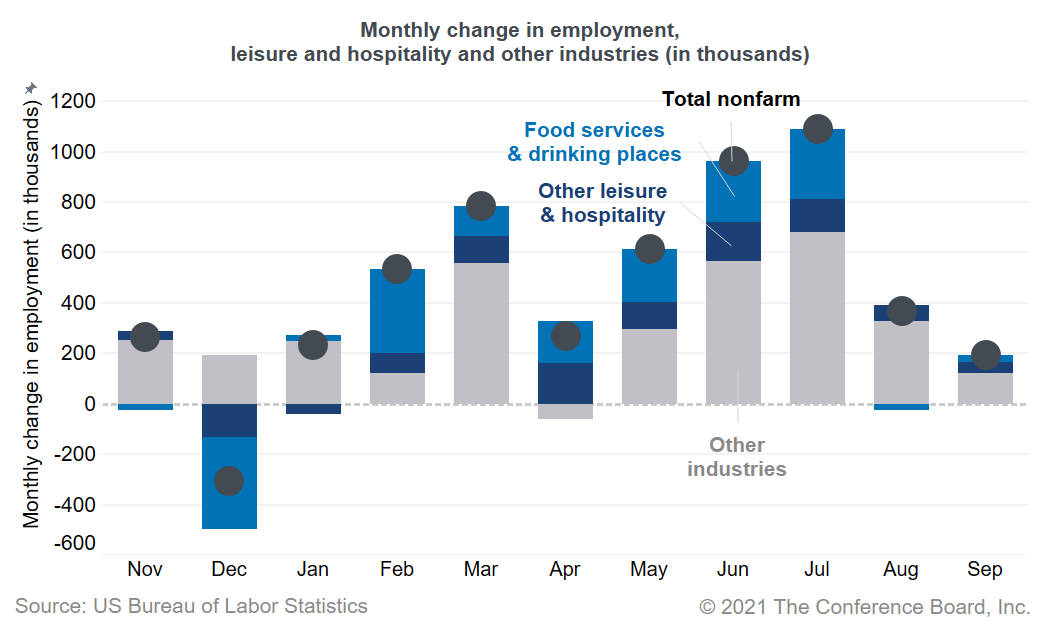-
Email
Linkedin
Facebook
Twitter
Copy Link

Loading...
Commentary on today’s U.S. Bureau of Labor Statistics Employment Situation Report Today’ jobs report showed the second consecutive month of lackluster job growth, reflecting Delta’s impact on the economy and a US labor market that remains tight. Nonfarm payroll employment increased by 194,000 in September, after an upwardly revised increase of 366,000 in August. The published unemployment rate ticked down from 5.2 to 4.8 percent, and the true rate, after adjusting for the misclassification error, declined from 5.5 to 4.9 percent. Overall, jobs still number 5 million below February 2020 levels, with women representing 57.5 percent of these employment losses. The labor force participation rate ticked down from 61.7 to 61.6 percent in September. Only 74,000 jobs were added in the leisure and hospitality industry, with food services and drinking places adding just 29,000 jobs. This weakness shows how the pandemic continues to hamper job growth, especially in the in-person services industries. Jobs were gained in retail trade, construction, and professional and business services. On the other hand, even though schools are reopening, private and government education declined by 179,700 jobs, possibly showing that some schools are not returning to prepandemic employment levels and vaccine mandates are constraining the return of some workers. While overall job growth was weak for the second consecutive month, peak disruption may be behind us with the number of COVID-19 cases nationally slowly declining. Today’s job numbers were collected in the first half of September when Delta cases were at their peak. If infections continue to decline over the coming months, job growth may pick up again, primarily in the in-person services industries. The labor market remains tight and labor shortages are perhaps getting even more severe. Average hourly earnings increased 6.0 percent (annual rate) over the past six months and other labor market indicators also show that employers are having difficulties attracting and retaining workers, especially in blue-collar and manual services jobs such as construction, production, transportation, personal care, and food services. This tight labor market with rising wages will feed into price inflation pressures. Hiring and retention difficulties could persist over the next several months. Some people continue to be fearful of catching the virus and are delaying a return to the labor market. In addition, the federal vaccine mandate for large private employers may be a new barrier to both recruitment and retention as some workers will not be willing to take the vaccine or get regularly tested. On the other hand, the expiration of elevated federal unemployment benefits and school reopenings may lead to more people and working parents returning to the labor market. As more people get vaccinated, job growth fluctuations should diminish. In addition, more people will become available to work and this should gradually lessen the pandemic-induced labor shortages. However, until now this does not appear to be the case. Employers may experience some relief in hiring difficulties during 2022 but not for long. By the end of 2022 or early 2023, the unemployment rate may have dropped below the prepandemic low of 3.5 percent, leading to a resurgence of regular labor shortages.
Cutting Discretionary Spending to Offset Higher Prices
March 28, 2025
Auto Makers Hit a Tariff Speedbump
March 27, 2025
Administration acts with Congress to reverse methane fee
March 25, 2025
Fed Keeps Cutting Bias amid “Transitory” Tariff Inflation
March 19, 2025
Retail Sales Show Consumers Are More Frugal amid Uncertainty
March 17, 2025
The EU's Retaliatory Tariffs Will Hit Beef, Bourbon and More
March 14, 2025
Charts
Consumer Confidence Declined for Second Consecutive Month in February
LEARN MORECharts
Omicron, Inflation, and Fed Dampen US Growth Prospects
LEARN MORECharts
Almost two years after the COVID-19 pandemic plunged the United States and the world into economic and social disruption, the nation is recovering.
LEARN MORECharts
High demand for labor is resulting in rapid hiring of the unemployed.
LEARN MORECharts
The Conference Board’s Salary Increase Budget Survey indicates that the average annual raise for current employees is accelerating.
LEARN MORECharts
The Conference Board Consumer Confidence Index® declined in November, following an increase in October. The Index now stands at 109.5 (1985=100), down from 111.
LEARN MORECharts
The Conference Board recently released its updated 2022 Global Economic Outlook.
LEARN MORECharts
America’s recent decline in global competitiveness raises concerns about the nation’s future economic stability and national security
LEARN MORECharts
Firms are struggling mightily to hire workers.
LEARN MORECharts
Crypto tokens--or cryptocurrencies---have a notional market value of more than $2.5 trillion today and are on pace to expand exponentially.
LEARN MOREFilter By Center
PRESS RELEASE
Global Productivity Growth Set to Disappoint Again in 2023
May 17, 2023
PRESS RELEASE
Stagnant Productivity Growth Returns
April 29, 2022
